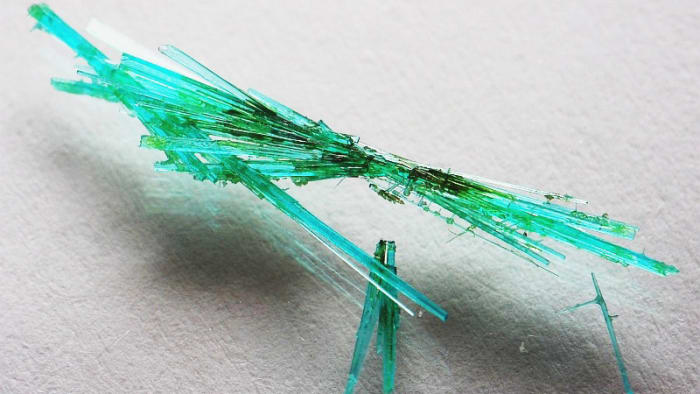How is copper chloride obtained
Reactions of obtaining CuCl₂ and CuCl

Before we answer the question concerning methods of the synthesis of copper chloride in this article, we should note that copper chloride can be bivalent, with the formula CuCl₂, and monovalent, with the formula CuCl. Naturally, because of their different quantitative composition, they have different properties and fields of application. Therefore, methods for the synthesis of these substances also differs.
Obtaining bivalent copper chloride CuCl₂
In natural conditions (i.e. in nature) this compound is encountered in the form of the rare mineral eriochalcite (the chemical composition of the crystalline hydrate CuCl₂·2H₂O – crystals of a blue color).

As bivalent copper chloride has important practical significance, the mineral found in nature is not sufficient to satisfy demand for it, and for this reason numerous methods for the artificial synthesis of this substance have been developed.
The main industrial method of synthesis of bivalent copper chloride is the reaction of the chlorination of copper sulfide at a high temperature (300-400 °C). The equation is:
CuS + Cl₂ = CuCl₂ + S
An alternative method for the synthesis of bivalent copper chloride is chloridizing roasting (at a temperature of at least 500 °C):
CuS + 2NaCl + 2O₂ = CuCl₂ + Na₂SO₄
The above reactions require specialized equipment and strict safety measures – for this reason they are only used in industry. However, copper chloride is frequently used in various types of work in the laboratory, so we should know how this substance can be obtained in the laboratory.
Interaction reaction of copper with chlorine
The equation is:
Cu + Cl₂ = CuCl₂
The reaction of bivalent copper oxide with hydrochloric acid
This method is used in the vast majority of cases because of its ease of implementation:
CuO + 2HCl = CuCl₂ + H₂O
An alternative to the previous method which is also known as the neutralization reaction:
Cu(OH)₂ + 2HCl = CuCl₂ + 2H₂O
Displacement reaction, in which the acid residue of the weaker acid is forced out by the stronger acid. In the vast majority of cases, widely available copper carbonate СuCO₃ is used:
CuCO₃ + 2HCl = CuCl₂ + H₂O + CO₂
Finally, the most original reaction, which involves dissolving copper in a mixture of strong acids, so-called “aqua regia”:
3Сu + 2HNO₃ + 6HCl = 3CuCl₂ + 2NO + 4H₂0
Bivalent copper chloride has found application in the decarboxylation and dying fabrics, and in the copper-coating of metals.

Here you’ll find safe experiments with copper compounds
Methods for obtaining monovalent copper chloride CuCl

This substance also has practical importance, and fans of chemistry will be interested to know how this compound can be obtained. Monovalent copper chloride was first obtained in 1666 by Robert Boyle, through the interaction of mercury(II) chloride and copper. In this reaction, the more active metal, copper, forces mercury out of its salts. The equation of this reaction is:
HgCl₂ + 2Cu = 2CuCl + Hg
The second method by which we can obtain monovalent copper chloride is by the thermal breakdown of bivalent copper chloride in oxygen-free conditions. This reaction was first carried out in 1799 by Joseph Louis Proust, who separated and described the chlorides of bivalent and monovalent copper. This equation of this reaction is:
2CuCl₂ = 2CuCl + Cl₂
In industry, copper(I) chloride is obtained by the interaction of chlorine and an abundance of copper in a flux of copper(I) chloride at high temperature.

It should be noted that chlorine is a highly toxic gas. Additionally, there are also safer laboratory methods, for example the reduction of copper(II) chloride by sulfur dioxide:
2CuCl₂ + SO₂ + 2H₂O → 2CuCl + H₂SO₄ + 2HCl
Or the reduction of CuCl₂ by ascorbic acid
Copper monochloride is used for purifying acetylene and carbon monoxide, and acts as a catalyst in organic synthesis and the production of several polymers.
Warning! Don’t try to repeat these experiments without a professional supervision!